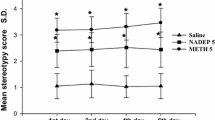Abstract
In male ICR mice, a single intraperitoneal administration of methamphetamine (METH) (10 mg/kg) induced stereotyped behavior such as continuous sniffing, circling, and nail biting, reaching a plateau level 20 min after the injection. Subcutaneous pretreatment with clorgyline, a monoamine oxidase (MAO)-A inhibitor, at a dose of 0.1 mg/kg 2 h prior to the drug challenge significantly decreased the initial (first 20 min) intensity of stereotypies and increased the latency to onset. The effect was not observed with either higher doses of clorgyline (1 and 10 mg/kg) or l-deprenyl, a MAO-B inhibitor, at doses of 0.1–10 mg/kg. In male Wistar rats, the inhibitory effect of clorgyline on METH-induced stereotypy was not observed. Pretreatment of the mice with clorgyline (0.1 mg/kg) had no effect on apparent serotonin and dopamine turnover in the striatum, although the higher doses of clorgyline (1 and 10 mg/kg) significantly decreased the turnover. These results suggest that a low dose of clorgyline tends to increase the latency and decrease the intensity of stereotypies induced by METH in a dopamine metabolism-independent manner in mice.
Similar content being viewed by others
References
S. H. Snyder (1972) ArticleTitleCatecholamines in the brain as mediators of amphetamine psychosis Arch. Gen. Psychiat. 27 169–179 Occurrence Handle4339577 Occurrence Handle1:STN:280:CS2B3s3gtVA%3D
E. H. Ellinwood M. M. Kilbey (1977) Chronic stimulant intoxication models of psychosis I. Hanin E. Usdin (Eds) Animal Models in Psychiatry and Neurology Pergamon Press New York 61–74
T. Nishikawa N. Mataga M. Takashima M. Toru (1983) ArticleTitleBehavioral sensitization and relative hyperresponsiveness of striatal and limbic dopaminergic neurons after repeated methamphetamine treatment Eur. J. Pharmacol. 88 195–203 Occurrence Handle10.1016/0014-2999(83)90006-7 Occurrence Handle6133769 Occurrence Handle1:CAS:528:DyaL3sXitV2qsr0%3D
T. E. Robinson J. B. Becker (1986) ArticleTitleEnduring changes in brain and behavior produced by chronic amphetamine administration: a review and evaluation of animal models of amphetamine psychosis Brain Res. Rev. 11 157–198 Occurrence Handle10.1016/0165-0173(86)90002-0 Occurrence Handle1:CAS:528:DyaL28Xlt1Kmurs%3D
L. S. Seiden K. E. Sabol G. A. Ricaurte (1993) ArticleTitleAmphetamine: Effects on catecholamine systems and behavior Annu. Rev. Pharmacol. Toxicol. 32 639–677
R. R. Gainetdinov A. R. Mohn M. G. Caron (2001) ArticleTitleGenetic animal models: Focus on schizophrenia Trends Neurosci. 24 527–533 Occurrence Handle10.1016/S0166-2236(00)01886-5 Occurrence Handle11506886 Occurrence Handle1:CAS:528:DC%2BD3MXlvFWgsL4%3D
R. E. Chipkin R. D. McQuade L. C. Iorio (1987) ArticleTitleD1 and D2 dopamine binding site up-regulation and apomorphine-induced stereotypy Pharmacol. Biochem. Behav. 28 477–482 Occurrence Handle10.1016/0091-3057(87)90509-0 Occurrence Handle2893388 Occurrence Handle1:CAS:528:DyaL1cXhs1OitQ%3D%3D
J. M. Delfs A. E. Kelley (1990) ArticleTitleThe role of D1 and D2 dopamine receptors in oral stereotypy induced by dopaminergic stimulation of the ventrolateral striatum Neuroscience 39 59–67 Occurrence Handle10.1016/0306-4522(90)90221-O Occurrence Handle1982467 Occurrence Handle1:CAS:528:DyaK3MXitVSiur4%3D
L. H. Conti D. S. Segal R. Kuczenski (1997) ArticleTitleMaintenance of amphetamine-induced stereotypy and locomotion requires ongoing dopamine receptor activation Psychopharmacology (Berl) 130 183–188 Occurrence Handle1:CAS:528:DyaK2sXisVersLw%3D
R. Kuczenski D. S Segal (1999) ArticleTitleSensitization of amphetamine-induced stereotyped behaviors during the acute response J. Pharmacol. Exp. Ther. 288 699–709 Occurrence Handle9918578 Occurrence Handle1:CAS:528:DyaK1MXpvFOnuw%3D%3D
E. H. Chartoff B. T. Marck A. M. Matsumoto D. M. Dorsa R. D. Palmiter (2001) ArticleTitleInduction of stereotypy in dopamine-deficient mice requires striatal D1 receptor activation Proc. Natl. Acad. Sci. USA 98 10451–10456 Occurrence Handle10.1073/pnas.181356498 Occurrence Handle11517332 Occurrence Handle1:CAS:528:DC%2BD3MXmvFWhs74%3D
D. L Murphy (1978) ArticleTitleSubstrate-selective monoamine oxidases: Inhibitor, tissue, species and functional differences Biochem. Pharmacol. 27 1889–1893 Occurrence Handle361047 Occurrence Handle1:CAS:528:DyaE1MXpvV2ktA%3D%3D
F. Fornai K. Chen F. S. Giorgi M. Gesi M. G. Alessandr J. C. Shih (1999) ArticleTitleStriatal dopamine metabolism in monoamine oxidase B-deficient mice: A brain dialysis study J. Neurochem. 73 2434–2440 Occurrence Handle10.1046/j.1471-4159.1999.0732434.x Occurrence Handle10582603 Occurrence Handle1:CAS:528:DyaK1MXns1ehu78%3D
InstitutionalAuthorNameInstitute of Laboratory Animal Resources (1996) Guide for Care and Use of Laboratory Animals National Academy Press Washington, DC
N. Kitanaka J. Kitanaka M. Takemura (2003) ArticleTitleBehavioral sensitization and alteration in monoamine metabolism in mice after single versus repeated methamphetamine administration Eur. J. Pharmacol. 474 63–70 Occurrence Handle10.1016/S0014-2999(03)02015-6 Occurrence Handle12909196 Occurrence Handle1:CAS:528:DC%2BD3sXlvFyms78%3D
N. Kitanaka J. Kitanaka M. Takemura (2005) ArticleTitleInhibition of methamphetamine-induced hyperlocomotion in mice by clorgyline, a monoamine oxidase-A inhibitor, through alteration of the 5-hydroxytryptamine turnover in the striatum Neuroscience 130 295–308 Occurrence Handle10.1016/j.neuroscience.2004.09.026 Occurrence Handle15664686 Occurrence Handle1:CAS:528:DC%2BD2MXhvFCmtw%3D%3D
N. Kitanaka J. Kitanaka M. Takemura (2005) ArticleTitleRepeated clorgyline treatment inhibits methamphetamine-induced behavioral sensitization in mice Neurochem. Res. 30 445–451 Occurrence Handle10.1007/s11064-005-2679-z Occurrence Handle16076014 Occurrence Handle1:CAS:528:DC%2BD2MXlvVemu78%3D
D. Weinshenker N. S. Miller K. Blizinsky M. L. Laughlin R. D. Palmiter (2002) ArticleTitleMice with chronic norepinephrine deficiency resemble amphetamine-sensitized animals Proc. Natl. Acad. Sci. USA 21 13873–13877
J. P. Finberg M. B. Youdim (1983) ArticleTitleSelective MAO A and B inhibitors: Their mechanism of action and pharmacology Neuropharmacology 22 441–446 Occurrence Handle10.1016/0028-3908(83)90194-6 Occurrence Handle6304562 Occurrence Handle1:CAS:528:DyaL3sXhsFCrsL4%3D
A. E. Felner P. C. Waldmeier (1978) ArticleTitleCumulative effects of irreversible MAO inhibitors in vivo Biochem. Pharmacol. 28 995–1002
I. C. Campbell M. J. Durcan R. M. Cohen D. Pickar D. Chugani D. L. Murphy (1985) ArticleTitleChronic clorgyline and pargyline increase apomorphine-induced stereotypy in the rat Pharmacol. Biochem. Behav. 23 921–925 Occurrence Handle10.1016/0091-3057(85)90093-0 Occurrence Handle4080777 Occurrence Handle1:CAS:528:DyaL28XhsFShsQ%3D%3D
K. E. Culver H. Szechtman (1997) ArticleTitleMonoamine oxidase inhibitor sensitive site implicated in sensitization to quinpirole Eur. J. Pharmacol. 339 109–111 Occurrence Handle10.1016/S0014-2999(97)01386-1 Occurrence Handle9473123 Occurrence Handle1:CAS:528:DyaK2sXotVOqurY%3D
K. E. Culver J. M. Rosenfeld H. Szechtman (2002) ArticleTitleMonoamine oxidase inhibitor-induced blockade of locomotor sensitization to quinpirole: Role of striatal dopamine uptake inhibition Neuropharmacology 43 285–393 Occurrence Handle10.1016/S0028-3908(02)00128-4
B. Levant J. D. Moehlenkamp K. A. Morgan N. L. Leonard C. C. Cheng (1996) ArticleTitleModulation of [3H]quinpirole binding in brain by monoamine oxidase inhibitors: Evidence for a potential novel binding site J. Pharmacol. Exp. Ther. 278 145–153 Occurrence Handle8764345 Occurrence Handle1:CAS:528:DyaK28XktlGgsr8%3D
N. MacInnes S. L. Handley (2005) ArticleTitleAutoradiographic localisation of [3H]2-BFI imidazoline I2 binding sites in mouse brain Eur. J. Pharmacol. 516 139–144 Occurrence Handle10.1016/j.ejphar.2005.04.006 Occurrence Handle15925361 Occurrence Handle1:CAS:528:DC%2BD2MXltFSqsLc%3D
Author information
Authors and Affiliations
Corresponding author
Rights and permissions
About this article
Cite this article
Tatsuta, T., Kitanaka, N., Kitanaka, J. et al. Effects of Monoamine Oxidase Inhibitors on Methamphetamine-Induced Stereotypy in Mice and Rats. Neurochem Res 30, 1377–1385 (2005). https://doi.org/10.1007/s11064-005-8390-2
Accepted:
Issue Date:
DOI: https://doi.org/10.1007/s11064-005-8390-2



